You know you want a hot tub. You can already picture yourself unwinding at the end of the day, letting the warm water and massaging jets work out the tension in your muscles. But now comes the big question: should you go with an in-ground hot tub or an above-ground spa?
An in-ground spa offers a sleek, built-in look that blends seamlessly with your backyard. It can feel like a natural extension of your outdoor space, creating a custom, high-end retreat. But the installation process is more involved than a traditional above-ground model.
From design options to the cost, looking at these key factors will help you decide if an in-ground hot tub is the right fit for your home.
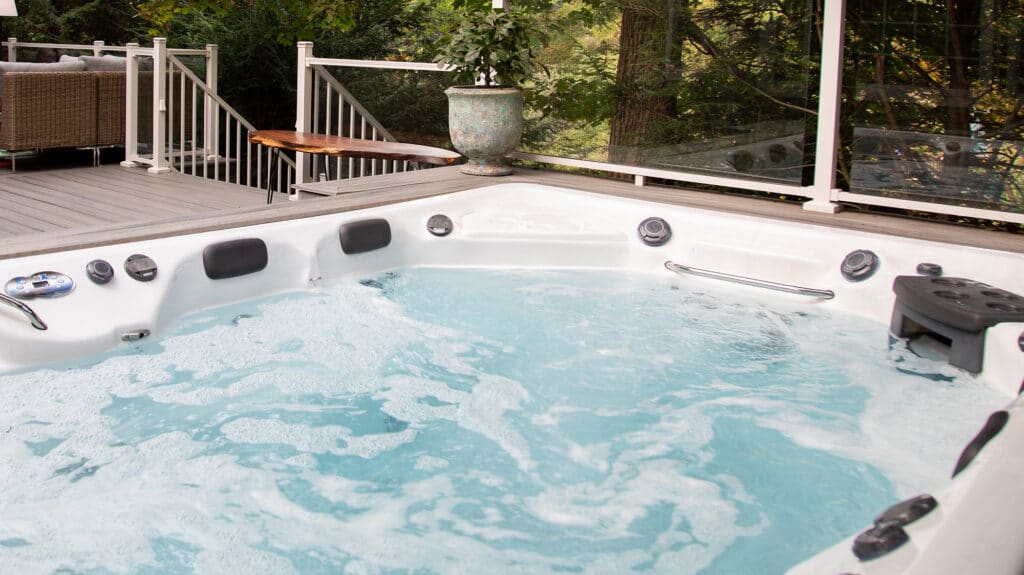
What is an in-ground hot tub?
When you picture an in-ground hot tub, do you imagine a round spa next to a pool? While that’s one common design, it’s far from your only option. In-ground hot tubs come in a wide range of styles and configurations, offering something for every backyard and personal preference.
A more traditional option, customized gunite spas are often built in conjunction with in-ground pools. The result is a cohesive outdoor retreat. Another choice is a pre-fabricated acrylic shell, which can be durable for an in-ground installation. You can even opt for a standalone portable hot tub, which can be installed partially recessed into the ground, in a deck, or a vault.
The defining feature of in-ground hot tubs is their integrated design. These spas are installed flush with the ground, often surrounded by custom stone, decking, or patios that blend naturally with your landscaping. Some designs may sit slightly above the surface, but they still offer a polished, custom look that complements your home’s outdoor design.
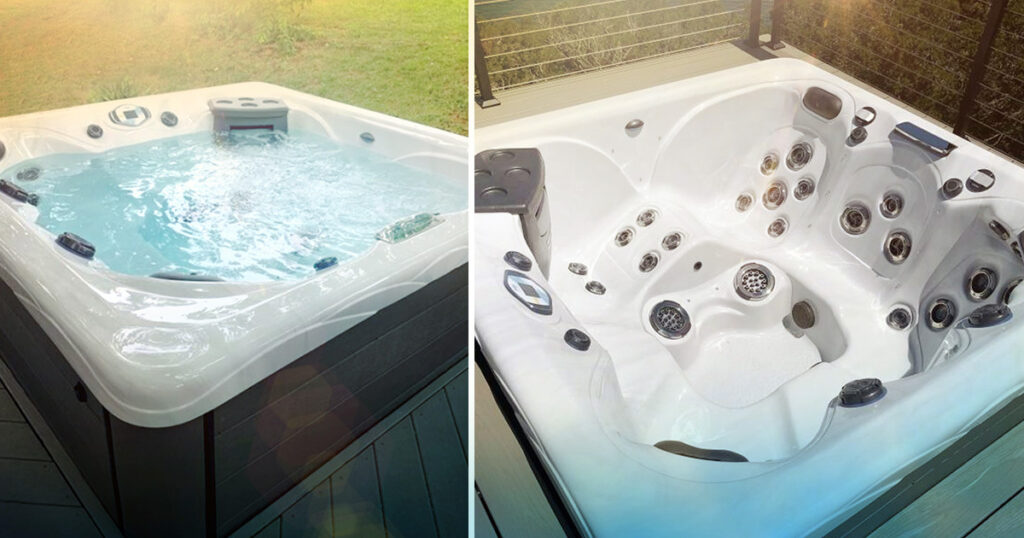
Comparing an above-ground spa and in-ground hot tub
When it comes to designing your perfect backyard oasis, beauty and relaxation go hand in hand. But deciding between an above-ground spa and an in-ground hot tub is no easy choice.
Both options offer incredible hydrotherapy benefits, but they differ significantly in design, accessibility, and long-term value. Understanding these differences will help you choose the spa that best suits your needs and enhances your outdoor space.
Aesthetics and backyard design
You have a vision for your backyard. Whether it’s a sleek, modern retreat or a cozy, inviting escape, your hot tub should complement the space. An in-ground spa can offer flexibility in size, shape, and materials, allowing you to design a custom look to match your existing landscape. You can also choose the surround, choosing from stone, tile, wood, or other materials.
Above-ground models, while available in standard hot tub sizes, still offer plenty of ways to complement your outdoor space. With a variety of cabinet finishes, acrylic colors, and LED lighting options, you can personalize the look to match your style. You can install it in a custom vault or on your patio to blend seamlessly into your backyard design, providing the same inviting and luxurious feel as a built-in spa.
Accessibility
Because an in-ground hot tub sits lower to the ground, entry can be seen as easier. Some designs feature built-in steps or ledges that let you sit and swing your legs in. However, a fully recessed spa can be more challenging to get in and out of, especially if you have mobility concerns.
Above-ground hot tubs typically require steps for entry, though they’re not always necessary. Many models can be paired with handrails or custom-built decking to improve accessibility.
Installation requirements
The installation process for in-ground hot tubs is more complex. Whether you choose a gunite or prefabricated model, you’ll need to plan for built-in plumbing and electrical connections.
Portable above-ground hot tubs, like those from Master Spas, have self-contained plumbing but still require a 240V/50-amp electrical connection. The setup is typically simpler and more cost-effective than installing a spa designed by a pool builder. In fact, once your site is ready, a standalone hot tub can be installed in less than a day.
Seating and comfort
In-ground spas are primarily designed for soaking rather than deep-tissue hydrotherapy. They often feature bench seating, which provides ample space but lacks ergonomic support, and basic jets that may not offer a therapeutic massage experience.
Portable hot tubs, like Master Spas, can offer comfort and hydrotherapy while being installed in the ground or on a patio. With contoured seating, lounge options, and strategically placed jets, they provide targeted relief for sore muscles and tension. Multiple pumps ensure a powerful massage, while features like the StressRelief Neck and Shoulder Seat focus on high-tension areas.
Year-round use
Hot tubs are especially enjoyable in the winter, but an in-ground spa requires additional heating to stay warm year-round. Gunite and prebuilt fiberglass models typically lack insulation, making them more expensive to heat.
A Master Spas hot tub, even when installed in a vault or recessed setting, retains its full insulation. This helps maintain water temperature more efficiently, keeping operating costs lower.
Longevity and home value
A well-designed in-ground hot tub can enhance your property’s appeal and increase its value. Its built-in nature makes it feel like a permanent luxury feature. Above-ground hot tubs, while more affordable, are considered portable and may not have the same long-term impact on home value.
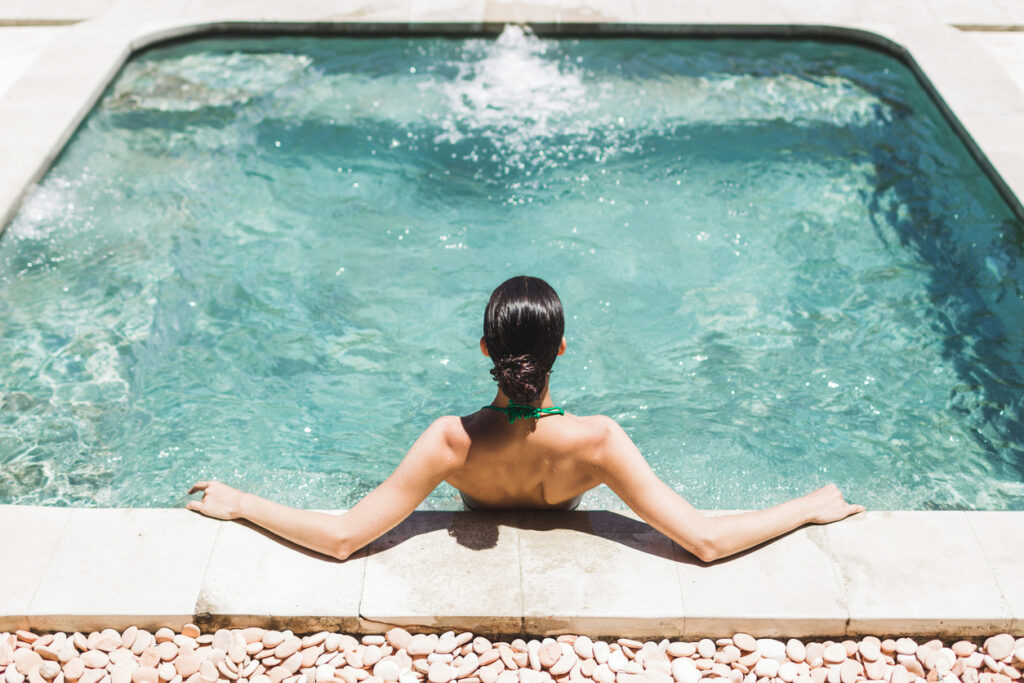
Installation considerations and costs
Installing an in-ground hot tub can require more planning and preparation than a traditional above-ground spa. From planning the site to the costs, there are some important factors to keep in mind when planning for this backyard upgrade.
Site preparation and excavation
Excavation is an expected step when installing an in-ground hot tub. Your contractor will dig out space based on your design plans, but it’s just as important to reinforce the structure. Whether it’s a gunite spa or a vault for a standalone hot tub, properly spaced rebar helps support the weight of the filled spa.
Drainage is another key consideration. Water pooling around the structure can cause damage over time, so a floor drain system should be built into the concrete pad. If you’re partially or fully recessing a Master Spas hot tub, this system will help direct excess water away, keeping both the spa and surrounding area protected.
Electrical and plumbing requirements
All hot tubs require electrical connections, but an in-ground installation may involve additional wiring and plumbing work. A licensed electrician and plumber should handle the setup to ensure everything meets local codes.
A standalone hot tub, on the other hand, comes with built-in plumbing, so there’s no need for additional pipes or water lines. You’ll still need a licensed electrician to install a 240V/50-amp connection. Once the spa is delivered, though, setup is straightforward. Just check the plumbing connections, fill it with water, and get ready to enjoy.
Access for maintenance
Hot tubs are built to provide years of relaxation, but you’ll still need access to the equipment for maintenance and potential repairs. With a built-in spa, like those installed alongside pools, access to pumps and other components should be factored into the design from the start.
If you’re installing a portable spa in the ground or within a deck, a service panel or designated access point is essential. Work with your contractor to ensure there’s enough space for upkeep. Master Spas recommends leaving at least three feet between the spa and the vault wall to give technicians room to work when needed.
Cost considerations
The cost of installing an in-ground hot tub depends on several factors, including the type of spa, excavation, materials, and labor. A custom gunite spa can start around $30,000 when added to a new pool build, but the price can be significantly higher for a standalone installation especially with upgrades like waterfalls, additional jets, and custom lighting.
Installing a portable hot tub in the ground also comes with excavation and vault preparation costs. However, with standalone hot tubs ranging from $8,000 to $20,000, you have more flexibility in choosing the right model for your space while keeping overall costs manageable.
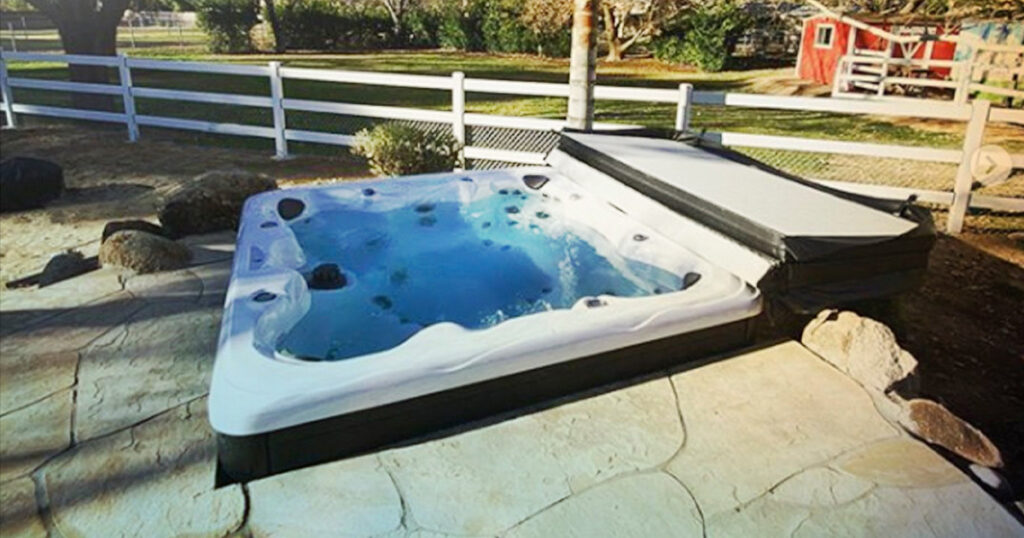
Best in-ground hot tubs from Master Spas
Master Spas hot tubs offer flexibility in both design and installation to fit your desired look and layout. While they are portable, they can be installed above ground, partially recessed, or fully integrated into your backyard. This means you get the advanced hydrotherapy and performance of an above-ground hot tub while achieving the seamless, high-end aesthetic of an in-ground spa.
Some of the best models for in-ground installation include:
LSX 900: A nine-foot spa with 72 premium hydrotherapy jets, a full-size lounge, and dedicated foot jets. This spacious hot tub delivers top-tier relaxation while achieving a high-end, built-in look.
Twilight Series 7.2 – One of Master Spas’ best-selling models, the Twilight Series 7.2 features a full-size lounge, ergonomic seating, and energy-efficient insulation, making it a great choice for in-ground installations.
Clarity Spas Precision 8 – Designed for socializing and family use, this spacious hot tub features an open seating layout with multiple seating options, providing flexibility and comfort for every user.
H2X Therapool D – If you’re looking for a larger spa with a party-ready feel, the 11-foot H2X Therapool D offers 54 jets, ergonomic seats, and bench seating. It’s perfect for entertaining while still delivering a soothing hydrotherapy (and aquatic exercise!) experience.
When installing a Master Spas hot tub in-ground, it’s important to work with a contractor or landscape designer to ensure proper support, drainage, and access for maintenance.
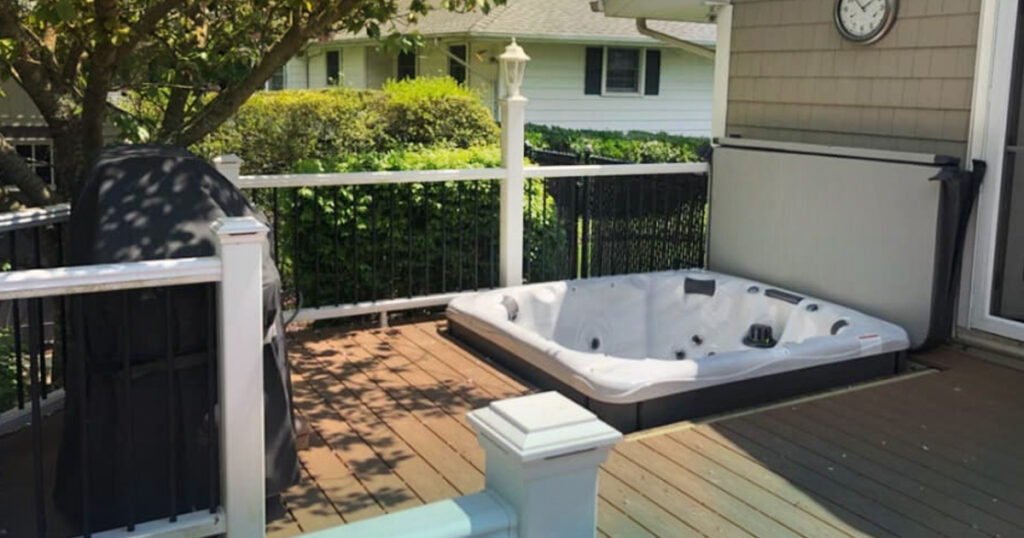
Is an in-ground hot tub right for you?
An in-ground hot tub is a significant investment, but for homeowners looking for a sleek, custom spa experience, it can be well worth it. If you’re considering this type of installation, take the time to evaluate your budget, backyard layout, and long-term maintenance needs.
For those who want the look of an in-ground hot tub without the extensive construction, Master Spas offers a range of hot tub models that can be installed in a recessed setting. Explore your options and find the best fit for your outdoor space.
Ready to take the next step? Contact a Master Spas hot tub dealer near you to learn more about installation options and pricing.


